

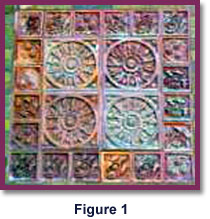
TILE BACK VIEWS # 12
Ludowici-Celadon
by Michael Padwee
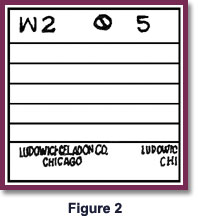 While reading The New York Times of March 25, I came across a wonderful article
about the reconstruction of the terra cotta tile dome of the New York City Center
(“Fixing a Leaky Roof, and What a Roof!: The Tale of the Tiles on City Center’s Cap”
by Glenn Collins, pp. B1, B8). The “Mecca Temple of the Ancient Arabic Order of
the Nobles of the Mystic Shrine”, built in 1922-1924 for the Shriners, was saved
from destruction by Mayor Fiorello LaGuardia in 1943. The original dome tiles
were manufactured by the Ludowici Tile Company, which has also recreated the
dome tiles for the reconstruction. (The other exterior and interior decorative
elements of City Center should not be missed by tile and terra cotta afficionados).
While reading The New York Times of March 25, I came across a wonderful article
about the reconstruction of the terra cotta tile dome of the New York City Center
(“Fixing a Leaky Roof, and What a Roof!: The Tale of the Tiles on City Center’s Cap”
by Glenn Collins, pp. B1, B8). The “Mecca Temple of the Ancient Arabic Order of
the Nobles of the Mystic Shrine”, built in 1922-1924 for the Shriners, was saved
from destruction by Mayor Fiorello LaGuardia in 1943. The original dome tiles
were manufactured by the Ludowici Tile Company, which has also recreated the
dome tiles for the reconstruction. (The other exterior and interior decorative
elements of City Center should not be missed by tile and terra cotta afficionados).
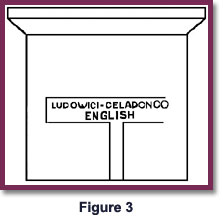 The Ludowici-Celadon Company of New Lexington, Ohio has a long history as the
manufacturer of roofing tiles. The Celadon Terra Cotta Company of Alfred, NY was
The Ludowici-Celadon Company of New Lexington, Ohio has a long history as the
manufacturer of roofing tiles. The Celadon Terra Cotta Company of Alfred, NY was
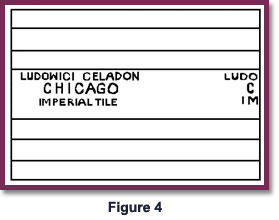 founded in 1889 when “it was discovered that the clay in the vicinity of Alfred
could be used to make quality terra cotta products.” The word, celadon, referred
to the resemblance of their greenish brick glaze to ancient Chinese ceramic work.
This company also catered to the decorative tastes of the era by manufacturing
ornamental tiles for the exterior of homes and business buildings. These tiles
include bas-relief heads, fruit, and geometric designs. (Figure 1 is a terra cotta
insert on the exterior wall of a local building).
founded in 1889 when “it was discovered that the clay in the vicinity of Alfred
could be used to make quality terra cotta products.” The word, celadon, referred
to the resemblance of their greenish brick glaze to ancient Chinese ceramic work.
This company also catered to the decorative tastes of the era by manufacturing
ornamental tiles for the exterior of homes and business buildings. These tiles
include bas-relief heads, fruit, and geometric designs. (Figure 1 is a terra cotta
insert on the exterior wall of a local building).
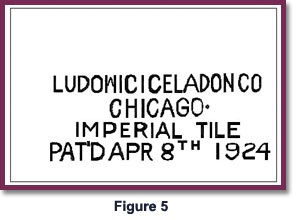 George Babcock, the first
president of Celadon, took out twenty-eight patents for roof tile patterns and
improvements. In 1906 this company was sold to the Ludowici Company of Ohio and
became the Ludowici-Celadon Company. In 1909 the tile plant in Alfred was
destroyed by fire. (Ludowici Roof Tile, A Historical Perspective published by
Ludowici Roof Tile, and The Celadon Terra Cotta Co. by Dr. Warren L. Bouck found
in Special Collections and Archives, Herrick Memorial Library, Alfred University)
George Babcock, the first
president of Celadon, took out twenty-eight patents for roof tile patterns and
improvements. In 1906 this company was sold to the Ludowici Company of Ohio and
became the Ludowici-Celadon Company. In 1909 the tile plant in Alfred was
destroyed by fire. (Ludowici Roof Tile, A Historical Perspective published by
Ludowici Roof Tile, and The Celadon Terra Cotta Co. by Dr. Warren L. Bouck found
in Special Collections and Archives, Herrick Memorial Library, Alfred University)
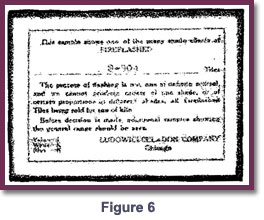 The Ludowici Roof Tile Company of Chicago, IL was founded in 1893 by Henry King,
Cyrus McCormick and Carl Ludowici. Shortly after 1906 the company had five
operating plants: the Alfred plant; the Chicago Heights plant, which may have once
been the United States Tile Roofing Company; the plant of the Western Roofing Tile
Company in Coffeyville, Kansas; a plant in Johnston Station (later renamed “Ludowici”),
Georgia; and a plant in New Lexington, Ohio. Ludowici remained strong up to the Depression,
and it remained viable during the depression with plants in New Lexington, OH, Coffeyville
and Peru, KS.
The Ludowici Roof Tile Company of Chicago, IL was founded in 1893 by Henry King,
Cyrus McCormick and Carl Ludowici. Shortly after 1906 the company had five
operating plants: the Alfred plant; the Chicago Heights plant, which may have once
been the United States Tile Roofing Company; the plant of the Western Roofing Tile
Company in Coffeyville, Kansas; a plant in Johnston Station (later renamed “Ludowici”),
Georgia; and a plant in New Lexington, Ohio. Ludowici remained strong up to the Depression,
and it remained viable during the depression with plants in New Lexington, OH, Coffeyville
and Peru, KS.
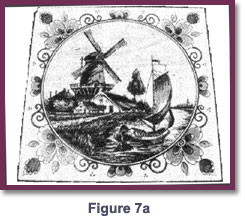 During World War II the New Lexington plant manufactured pottery.
Nearly 200 women were employed at this time making hand decorated pottery, cookie jars
and other tableware, and it is probably during World War II that Ludowici-Celadon made
some art tiles along with the Walt Disney and Turnabout cookie jars and other pottery.
The only roof tile Ludowici manufactured was for military installations like Hickam Field
at Pearl Harbor. After the war, Ludowici, again, began to expand production of roofing tile,
and it is still in business today. (Ludowici Roof Tile, A Historical Perspective, and
Lehner’s Encyclopedia of U.S. Marks on Pottery, Porcelain & Clay, by Lois Lehner, Collector Books, 1988)
During World War II the New Lexington plant manufactured pottery.
Nearly 200 women were employed at this time making hand decorated pottery, cookie jars
and other tableware, and it is probably during World War II that Ludowici-Celadon made
some art tiles along with the Walt Disney and Turnabout cookie jars and other pottery.
The only roof tile Ludowici manufactured was for military installations like Hickam Field
at Pearl Harbor. After the war, Ludowici, again, began to expand production of roofing tile,
and it is still in business today. (Ludowici Roof Tile, A Historical Perspective, and
Lehner’s Encyclopedia of U.S. Marks on Pottery, Porcelain & Clay, by Lois Lehner, Collector Books, 1988)
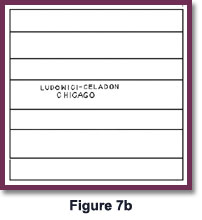 Figures 2 to 6 illustrate various Ludowici-Celadon roofing tile backs while
Figures 7 and 8 illustrate Ludowici art tiles: Figure 2 is a 4” unglazed
red clay tile with impressed marks on two of four raised bars; Figure 3 is
a flat roof “English” pattern tile with raised marks; Figure 4 is a 9” x 6 1/4”
red clay body, Imperial pattern roof tile with impressed marks in one of three
recessed bars; Figure 5 is
Figures 2 to 6 illustrate various Ludowici-Celadon roofing tile backs while
Figures 7 and 8 illustrate Ludowici art tiles: Figure 2 is a 4” unglazed
red clay tile with impressed marks on two of four raised bars; Figure 3 is
a flat roof “English” pattern tile with raised marks; Figure 4 is a 9” x 6 1/4”
red clay body, Imperial pattern roof tile with impressed marks in one of three
recessed bars; Figure 5 is
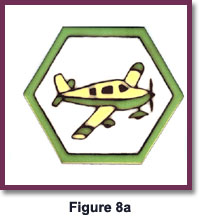 another impressed “Imperial” pattern tile mark with
the patent date (not a full tile
back); and Figure 6 is a 4” x 3” paper label
found on the back of a sample roof tile. Figures 7.a and 7.b are the obverse
and reverse of a Ludowici transfer tile of a windmill. This 6” red clay body
tile has impressed marks in one of three recessed bars. Figures 8.a and 8.b
are the obverse and reverse of a hexagonal, cuenca-style tile of a
propeller-driven airplane. This red clay body tile is 6 1/8”H and 7 3/16” W.
There are 51 alternating raised
and recessed (darkened) bars, and the impressed marks are on raised bar.
another impressed “Imperial” pattern tile mark with
the patent date (not a full tile
back); and Figure 6 is a 4” x 3” paper label
found on the back of a sample roof tile. Figures 7.a and 7.b are the obverse
and reverse of a Ludowici transfer tile of a windmill. This 6” red clay body
tile has impressed marks in one of three recessed bars. Figures 8.a and 8.b
are the obverse and reverse of a hexagonal, cuenca-style tile of a
propeller-driven airplane. This red clay body tile is 6 1/8”H and 7 3/16” W.
There are 51 alternating raised
and recessed (darkened) bars, and the impressed marks are on raised bar.
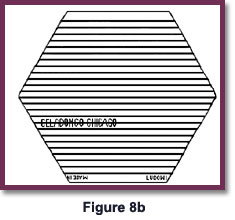
I did contact the Ludowici Tile Company and asked if they had any information on their art tile production. They didn’t, however, where there are two tiles like those above, there must have been others made. Please contact me at MPADWEE@nyc.rr.com if you have any more information about Ludowici art tiles.
Click here for the previous Tile Back Views:
J. Mayer Co.